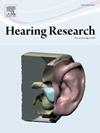OSBPL2 deficiency impaired cochlear blood-labyrinth barrier via activation of NF-κB signaling pathway
IF 2.5
2区 医学
Q1 AUDIOLOGY & SPEECH-LANGUAGE PATHOLOGY
引用次数: 0
Abstract
OSBPL2 was one of the causal genes responsible for autosomal dominant non-syndromic hearing loss (DFNA) and the pathogenic mechanism of OSBPL2 mutations remain elusive. OSBPL2 was detected to be highly expressed in stria vascularis (SV) of mouse cochleae, in which the blood-labyrinth barrier (BLB) was located as an essential component of cochlear spiral duct. The present study explored a potential pathologic mechanism of OSBPL2 deficiency underlying the structural and functional impact on BLB. Osbpl2-knockout (KO) mice were used to characterize SV permeability, which was measured using FITC-dextran injection. OSBPL2-deficient human umbilical vein endothelial cells (HUVECs) were used to evaluate the endothelial permeability in vitro. Tight junctions (TJs) in SV and HUVECs were characterized using immunofluorescent staining. The results showed that significant SV leakage was detected in cochleae of 10-month-old Osbpl2-KO mice, which was consistent with the increased endothelial permeability in OSBPL2-deficient HUVECs. It was also noted that OSBPL2 deficiency led to TJs disruption and induced inflammation-mediated apoptosis via the activation of NF-κB signaling. This study revealed the potential pathogenic mechanism of OSBPL2 deficiency in SV lesion, which helped to elucidate the underlying pathogenesis of OSBPL2 mutations in DFNA.
OSBPL2缺乏通过激活NF-κB信号通路损害耳蜗血迷宫屏障
OSBPL2是常染色体显性非综合征性听力损失(DFNA)的致病基因之一,OSBPL2突变的致病机制尚不清楚。在小鼠耳蜗血管纹(SV)中检测到OSBPL2高表达,其中血迷宫屏障(BLB)是耳蜗螺旋管的重要组成部分。本研究探讨了OSBPL2缺乏对BLB结构和功能影响的潜在病理机制。osbpl2敲除(KO)小鼠表征SV通透性,采用fitc -葡聚糖注射测量。采用osbpl2缺陷人脐静脉内皮细胞(HUVECs)体外评价内皮细胞的通透性。免疫荧光染色法对SV和HUVECs的紧密连接(TJs)进行了表征。结果显示,10月龄Osbpl2-KO小鼠耳蜗中检测到明显的SV渗漏,这与osbpl2缺陷huvec内皮细胞通透性增加一致。研究还指出,OSBPL2缺乏通过激活NF-κB信号通路导致TJs破坏并诱导炎症介导的细胞凋亡。本研究揭示了SV病变中OSBPL2缺失的潜在致病机制,有助于阐明DFNA中OSBPL2突变的潜在发病机制。
本文章由计算机程序翻译,如有差异,请以英文原文为准。
求助全文
约1分钟内获得全文
求助全文
来源期刊

Hearing Research
医学-耳鼻喉科学
CiteScore
5.30
自引率
14.30%
发文量
163
审稿时长
75 days
期刊介绍:
The aim of the journal is to provide a forum for papers concerned with basic peripheral and central auditory mechanisms. Emphasis is on experimental and clinical studies, but theoretical and methodological papers will also be considered. The journal publishes original research papers, review and mini- review articles, rapid communications, method/protocol and perspective articles.
Papers submitted should deal with auditory anatomy, physiology, psychophysics, imaging, modeling and behavioural studies in animals and humans, as well as hearing aids and cochlear implants. Papers dealing with the vestibular system are also considered for publication. Papers on comparative aspects of hearing and on effects of drugs and environmental contaminants on hearing function will also be considered. Clinical papers will be accepted when they contribute to the understanding of normal and pathological hearing functions.
 求助内容:
求助内容: 应助结果提醒方式:
应助结果提醒方式:


